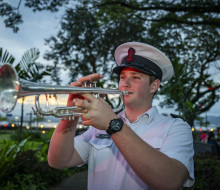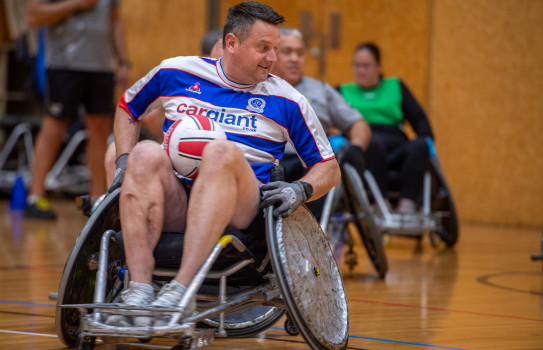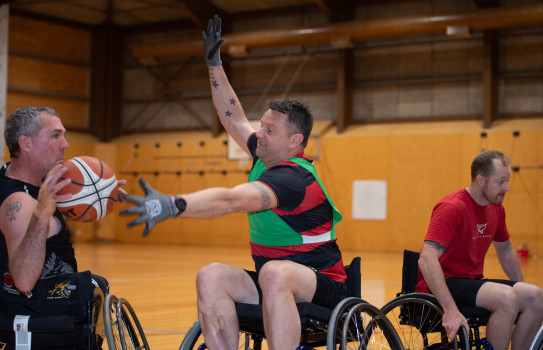
Taupō trumpeter in demand in brand new career with Royal New Zealand Navy Band
26 August 2025
Unfortunately you are viewing this website on an outdated browser which does not support the necessary features for us to provide an adequate experience. Please switch to a modern browser such as latest version of Google Chrome, Mozilla Firefox, Apple Safari or Microsoft Edge.
Ngā mihi nui
Nearly 24 years ago New Zealand Army Warrant Officer Class One (WO1) Ed Dore-Wright was preparing to deploy to East Timor for a second time when he was involved in a live-fire training accident which went horribly wrong.
An accidental burst of a machine gun fire hit him in the right leg.
“I knew that I had been shot, but didn’t understand in that moment the extent of my injuries, I fell to the ground.”
“Despite being in severe pain, I joked with my platoon members that my Red Diamond infantry patch on my uniform was faulty and that I needed another one. As infantry soldiers we would say that our Red Diamond would always keep us safe and warm.”
After being airlifted from Waiouru to Palmerston North Hospital, doctors explained that the damage to muscle, bone, artery and nerves would likely result in amputation.
“I was having none of it, I could move my big toe, so they weren’t allowed to chop off my leg. I later found out if I hadn’t of been so stubborn my leg would have been amputated.”
WO1 Dore Wright had a number of operations to clean out the damage in his leg so that the four main surgeons on his case had a clearer picture of what damage there was, and what could be saved.
“All four doctors said that on medical grounds my leg should be amputated, however two of the four said if I was prepared for the battle to attempt to save it then they would try for me. My answer was an immediate yes, I want my leg,” he said.
Transferring to a specialist plastics surgery unit in Wellington he had his first major operation a few days later – doctors said that if blood flow to the muscle graft wasn’t viable then they would have to amputate his leg.
“This was my most nervous time, I went to sleep under anesthetic and the doctors went about their magic for a few hours.
“Upon waking from surgery I immediately asked if I still had my leg. I got the answer I wanted, yes and the surgery went extremely well.
The relief I experienced was out of this world, but this was just the start of the journey.

He was told by doctors following surgery that he wouldn’t be able to continue being a soldier with the demands on his body, would never be able to walk unaided, drive a manual car, or play football again. He eventually proved them wrong on all counts and he remains in the NZ Army.
Adapting to life following the injury and surgery was daunting and very tough, he had to learn to walk again both with and then without a walking aid.
“The simple task of walking and trying to get the nerves talking to each other and link up was frustrating for me.
I was up against all odds to keep my leg, then more so have it functioning normally.
“I still can’t feel large parts of my right foot, including most toes and the pad of my foot itself, and no feeling on the muscle graft itself and surrounding areas.
“However, in those early days what I did start to focus on was that I saw that the recovery time in between workouts was less and less this was great for my mental state as I had a positive that I could use,” he said.
Support from his family, particularly his wife Janet, was what got him through.
“I remember being in a lot of pain during my recovery process, but mentally I was affected just as much if not more. I was not the most pleasant person to be around.
“My wife Janet and I had only been married three months and she was and still is my rock – she has definitely ticked off ‘in sickness and health’ as part of the vows of marriage.”
WO1 Dore-Wright saw five psychologists through his recovery and had given up on the potential of these professionals being able to help him after number four.
“I was over it, but luckily for me Janet insisted I gave this last psychologist, Victor, a chance as I was still going through the mental process of accepting my injury.
“One of the hard parts for me was the reaction of people to my injuries, people would often unashamedly stare at my leg if I was wearing shorts, and this would push all my emotional buttons.
“Victor started to work his magic on me and had the ability to get me to talk without me realising what I was talking about. I had a lot of anger, frustration, resentment and fear built up inside of me and over time he gave me the ability to use the key and unlock the hidden emotions,” he said.
Within a year of his injury WO1 Dore-Wright was back doing all the things that he was told he wouldn’t be able to do, including playing his passion sport of football.
“Football was a massive driving factor for my recovery,” he said.

WO1 Dore-Wright will complete as part of a 19-strong New Zealand Team at the first-ever winter Invictus Games in Vancouver Whistler from 8-16 February.
He will take part in cross-country skiing, indoor rowing, wheelchair basketball, and wheelchair rugby.
He said that he applied for the 2025 Games he believes his journey is at the right stage for himself and his family.
“It is a great opportunity for me to continue my personal journey and gain some valuable experience that I can hopefully share with others.
“I believe that the Invictus Games gives wounded, injured and ill the ability to move forward – a situation shared is a situation halved.”
WO1 Dore-Wright said being part of the Invictus whānau has provided extended family for him and he hopes to put in the best effort he can in Canada, whilst also having fun doing it.
Recovery is an individual journey, but sharing your experiences will not only help you, but help others.
Head to our Invictus Games webpage(external link)